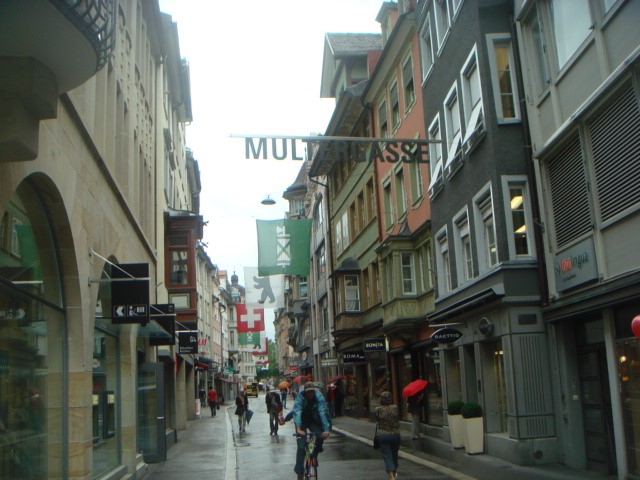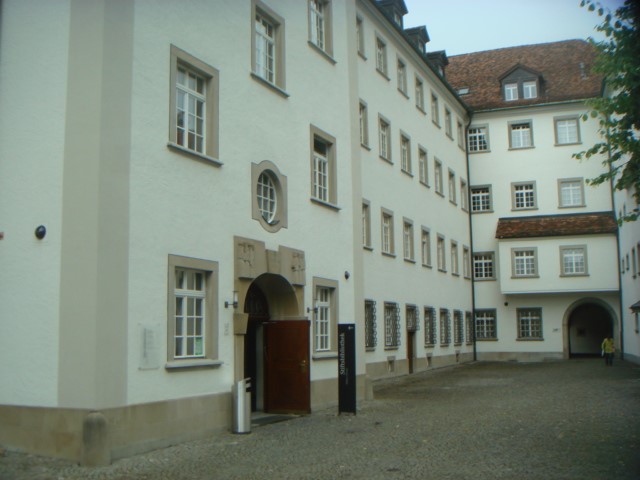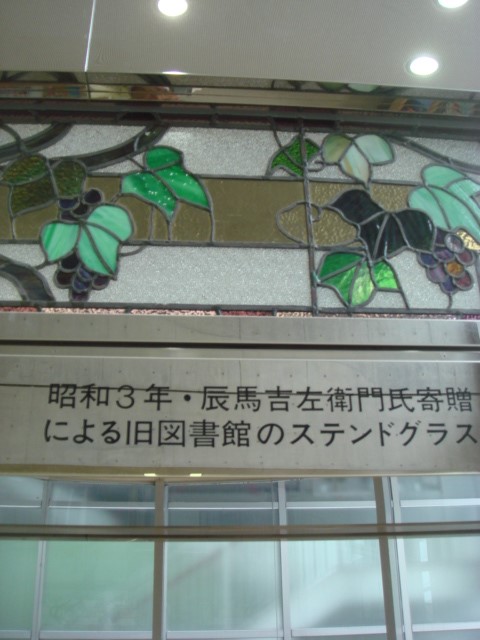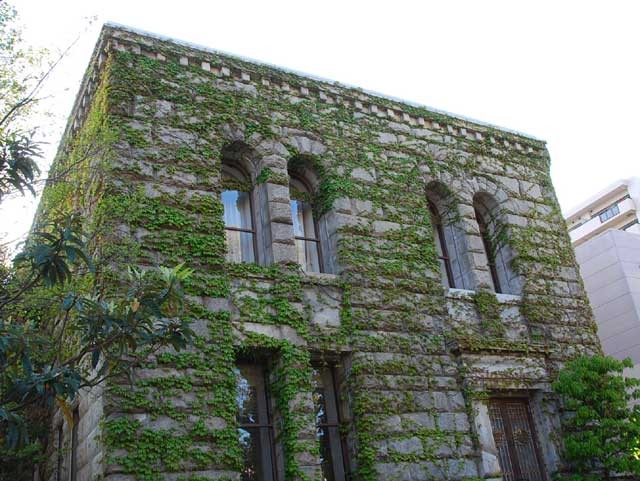| The Hanshinkan Kid (4): Libraries Haruki Murakami's love affair with libraries |
||||
| @@@ | ||||
|
In July 2010, I traveled one hour by train from Zurich to St. Gallen, a picturesque town near the Swiss border with Austria,
to investigate a local connection to Haruki Murakami. I was on a quest to visit the fabled library at the Abbey of Saint Gall, a Roman Catholic complex in the old city. | ||||
 @ @ |
||||
| The Abbey of Saint Gall | ||||
| The Convent of St. Gall, a magnificent monastery built in the 18th century,
and, its library, which boasts a rich collection of rare medieval manuscripts, are on the UNESCO World Heritage list. A pair of artists created an installation in the library in 2005, and a photographic collection of the 3-D artwork was published in November the same year. Murakami wrote a foreword to the book. | ||||
 @ @ |
||||
| A photographic collection of the 3-D artwork | ||||
| > | I wanted to see the library with my own eyes and was interested in finding out how the acclaimed
writer became involved in the photo book. I had no idea about how to reach the abbey when I arrived at the station. | |||
 @ @ |
||||
| Old town of Saint Gall | ||||
 @ @ |
||||
| But after visiting a tourist information office in the station and a bookstore in the town that had a corner
devoted to Murakamifs works, I found myself standing in front of the library. | ||||
 @ @ |
||||
| The library of the Abbey | ||||
| Adjacent to the abbey cathedral, known as a splendid monument of Baroque architecture, the library itself
was a low-key building with few decorations. When I went inside, however, I was overwhelmed by a majestic atmosphere created by a combination of walls of bookshelves filled with sumptuous books, statues of angels decorating various parts of the interior and masterful sprawling ceiling paintings. | ||||
 @ @ |
||||
| According to an official at the library, one of the two artists who created the installation,
Gerda Steiner and Joerg Lenzlinger, was a fan of Murakamifs novels and asked the Japanese writer to write a foreword to the photo book. The library official also said the installation itself was inspired by Murakamifs novel in which a library with a collection of the skulls of unicorns appeared. That must be his gHard-Boiled Wonderland and the End of the World.h Later on, I borrowed the photo book, gSeelenwarmer" (Soul Warmer), from a Japanese library and found a photo of the installation showing the skull of a horned animal decorating a wall in the Abbey library along with flowers and other plants. | ||||
  |
||||
| In his foreword to the book, titled gA Good Cycle of Stories,h Murakami
described his boyhood years in the "Hanshinkan" area and his experiences
with libraries in the neighborhood. The cities of Nishinomiya and Ashiya are
often called "Hanshinkan" because they are located between Osaka and Kobe. "Hanshin" is the word created by combining two kanji representing Osaka and Kobe, while "kan" means in-between. gI walked around from one bookshelf to another in the room devoted to books for boys, watched countless stories which had come from all kinds of countries of today and in the past to pack the bookshelves, and reveled in dazzling sensations,h Murakami wrote. gOnce I opened a book, I could easily enter the fantasy world unfolding on its pages. I returned to this world when I closed the book.h At a corner of the Swiss medieval library with a rich historical heritage, an artistic installation inspired by a literary work of Murakami, who has an intense love of libraries, was created. And he wrote a foreword to the photo collection of the installation. It was an exciting discovery for me to find that a Japanese writer nurtured by libraries in the Hanshinkan area was deeply connected to foreign artists through a library. IMPORTANT SCENES AT LIBRARIES Indeed, libraries seem to be very important facilities for Murakami. Libraries are places where important scenes unfold in many of his stories. In his debut novel, gHear the Wind Sing,h the third woman the protagonist dates is a coed majoring in French literature he comes to know in the universityfs library. In his g1Q84,h Aomame, one of the key characters in the novel, goes to a municipal library to do research. His short story gToshokan Kitan" (library mystery) and gFushigina Toshokan" (mysterious library), a picture book that is based on the former and coauthored by Murakami and Maki Sasaki, are both a story about encountering a weird old man living in the basement of a municipal library and having mysterious experiences with him. In his gHard-Boiled Wonderland and the End of the World,h which won the Tanizaki Junichiro Award, a library that has a large collection of the skulls of unicorns serves as an important place for story development. The most famous Murakami novel in which a library plays a key role is gKafka on the Shore.h In the last chapter of the novel, one character referred to the library and said, gItfs a unique, special library. And nothing else can ever take its place.h MODEL FOR 'KAFKA ON THE SHORE' Murakami has mentioned two specific libraries as his boyhood haunts: the former Nishinomiya City Library and the former Ashiya City Library. | ||||
 @ @ |
||||
| The former Nishinomiya City Library | ||||
| Ifm convinced that the Komura Memorial Library, the one in gKafka on the Shore,h
is modeled on these two municipal libraries in neighboring Nishinomiya and Ashiya. More than a decade ago, I took advantage of an opportunity for Murakamifs readers to exchange e-mails with the writer through an open website and presented this theory to him. But Murakami rejected my speculation, saying, gThe Komura Memorial Library is just itself and there is no model for it. It is purely a product of my imagination.h Immediately after gKafka on the Shoreh was released, there was much speculation about the model for the Komura Memorial Library. Various views were circulating among Murakami fans, such as, gThere is a library in Shikoku that fits the descriptions of the Komura library.h I was born and raised in the city of Nishinomiya and frequented the former Nishinomiya City Library. I still live just several hundreds of meters from the site of the library. I also once lived in the city of Ashiya and was in the same year in school as Murakami. My theory about the model for the Komura library is based on my geographical knowledge about the area and my personal experiences during that era. | ||||
  |
||||
| A stained-glasswindow of the former Nishinomiya City Library | ||||
| In gKafka on the Shore,h there is a description about the Komura library that
is reminiscent of a stained-glass window of the former Nishinomiya City Library. Although the Komura library is described as
an old Japanese house, it has a stained-glass window. gOn a stained-glass window next to the landing, a
deer stretches out its neck to nibble at some grapes.h | ||||
 @ @ |
||||
| The Uchide branch of the current Ashiya City Library | ||||
| The building of the former Ashiya City Library still exists, used as the Uchide branch of the current Ashiya City Library.
In his 2001 work, titled "Murakami Asahido: Smerdyakov Tai Oda Nobunaga Kashindan" (Murakami's house of the rising sun: Smerdyakov versus an army of
samurai retainers for warlord Oda Nobunaga), Murakami said he personally liked the old Ashiya City Library the most. My conjecture is that I hit the nail on the head with my theory about the model for the Komura library presented to him in my e-mail. He didnft say yes simply to avoid disappointing his readers who had different theories. In an interview, Murakami cited five books he read at the former Nishinomiya City Library. They included Japanese translations of three French classics: gVoyage au centre de la Terre" ("Journey to the Center of the Earth") by Jules Verne; gVingt mille lieues sous les mers" ("Twenty Thousand Leagues Under the Sea") by Jules Verne; and gLes Trois Mousquetaires" ("The Three Musketeers") by Alexandre Dumas. I read these three books at the same library. Perhaps, Murakami and I happened to pick up the same books around the same time at the same library. As a Hanshinkan kid myself, I am secretly proud of this coincidence. | ||||
Copyright Since 2009 OFFICE ATSURO KAWAUCHI. All rights reserved.